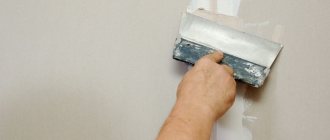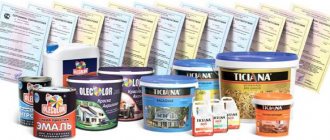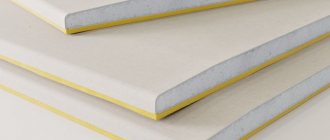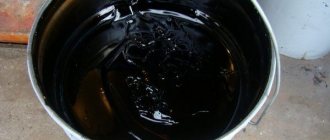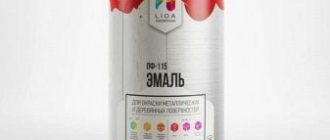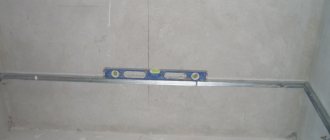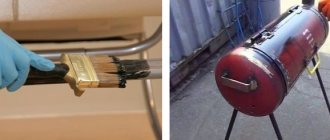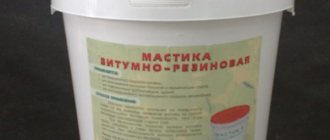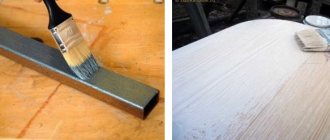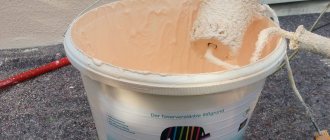Primers FL-03K and FL-03Zh were developed in the late 70s of the twentieth century, but are still very popular.
It is important to note that the scope of application of FL-03K
and
FL-03Zh
is diverse:
- mechanical engineering;
- bridge construction;
- machine tool industry;
- metal structures and structures;
- automotive industry;
- military-industrial complex;
- railway equipment.
FL-03 primer is produced in accordance with GOST 9109-81 and is a suspension of pigments and fillers in a film former based on phenol-formaldehyde resins modified with vegetable oils.
Primer FL-03K is used for priming surfaces of both ferrous metals and non-ferrous metals - copper and titanium alloys. It is allowed to apply primer FL-03K on wooden surfaces.
The purpose of the FL-03Zh primer is to prime surfaces made of ferrous and non-ferrous metals and their alloys, as well as wooden surfaces.
TECHNICAL REQUIREMENTS
1.1. Primers FL-0ZK and FL-0ZZH must be produced in accordance with the requirements of this standard according to recipes and technological regulations approved in the prescribed manner.
1.2. (Deleted, Amendment No. 2).
1.3, 1.4. (Excluded, Amendment No. 3).
1.5. Primers must comply with the requirements and standards specified in table. 1.
Table 1
| Indicator name | Standard for primer | Test method | |
| FL-03K OKP 23 1243 0109 01 | FL-03ZH OKP 23 1243 0104 06 | ||
| 1. Film color | Brown, shade is not standardized | Yellow-green, shade is not standardized | According to clause 4.3 |
| 2. Appearance of the film | After drying, the film should be smooth, uniform, matte or semi-matte or semi-gloss | According to clause 4.3 | |
| 3. Conditional viscosity at a temperature of (20.0 ± 0.5) ° C according to a viscometer type VZ-246 (or VZ-4), s, not less | 40 | 40 | According to GOST 8420 and clause 4.3a of this standard |
| 4. Degree of dilution with solvent, %, no more | 25 | 20 | According to clause 4.4 |
| 5. Mass fraction of non-volatile substances, % | (61 ± 3) | (58 ± 3) | According to GOST 17537, section. 1 and clause 4.5 of this standard |
| 6. Degree of grinding, microns, no more | 40 | 30 | According to GOST 6589 |
| 7. Drying time at (20 ± 2) °C, h, no more | According to GOST 19007 | ||
| up to degree 3 | 8 | 8 | |
| at (105 ± 5) °С, min, no more | |||
| up to degree 4 | 35 | 35 | |
| 8. Film hardness using a pendulum device, conventional units, not less than: | According to GOST 5233 and clause 4.6 of this standard | ||
| after drying at a temperature of (20 ± 2) °C | |||
| type M-3 | 0,36 | 0,36 | |
| type TML (pendulum A) | 0,20 | 0,20 | |
| after drying at a temperature of (105 ± 5) °C | |||
| type M-3 | 0,5 | 0,5 | |
| type TML (pendulum A) | 0,30 | 0,30 | |
| 9. Elasticity of the tape when bending mm, no more | 1 | 1 | According to GOST 6806 |
| 10. Film strength when impacted by a U-1 type device, cm, not less | 50 | 50 | According to GOST 4765 |
| 11. Film adhesion, points, no more | 1 | 1 | According to GOST 15140, section. 2 |
| 12. Film resistance to static action of 3% sodium chloride solution at (20 ± 2) °C, h, not less | 24 | 24 | According to GOST 9.403, section. 2 and clause 4.8 of this standard |
| 13. Resistance of the film to the static effects of industrial oil at a temperature of (20 ± 2) °C, h, not less | 72 | 72 | According to GOST 9.403, section. 2 and clause 4.9 of this standard |
| 14. The ability of the coating to be sanded | When sanding, the coating should form a smooth surface and not stain the sandpaper. | According to clause 4.10 | |
Notes:
1. The formation of sediment during storage is allowed if, after thorough stirring and dilution according to indicator 4 of the table. 1 primer will meet all the requirements of this standard.
2. The standard for indicator 8 when determining hardness using a pendulum device of the TML type is not rejected until 01/01/93.
(Changed edition, Amendment No. 1, 2).
Scope of application
Material FL-03 is a phenolic primer, including pigments and fillers that form a film after drying. It is made on the basis of phenolic resins converted with vegetable oils, in compliance with the rules of GOST 9109-81.
Depending on the color, there are FL-03K and FL-03ZH. This is the most suitable option for priming ferrous and non-ferrous metal substrates, copper and titanium alloys. Suitable for use on wooden structures.
Scope of application of primers in various industries:
- mechanical engineering;
- bridge construction;
- machine tool industry;
- metal structures and structures;
- automotive industry;
- military-industrial complex;
- railway equipment.
The use of soil acts as protection for objects located in the external environment, including in the industrial sector. This composition is not subject to destruction from industrial oils, gasoline, chemical compounds, salts, and mineral oils. An additional property of the material is the ability to use it in situations not only of mild climates, but also of high humidity and temperature. FL-03 easily withstands the influence of water, moisture, low and high temperatures.
It is also important to consider that when applied, the primer forms the electrical resistance and dielectric constant of the object.
SAFETY REQUIREMENTS
2.1. Primers FL-03K and FL-03Zh are a fire hazardous and toxic material, which is due to the properties of the solvents and chromates that make up the primers. Solvent vapors included in primers have an irritating effect on the mucous membranes of the eyes, respiratory tract and skin.
2.2. The fire hazard and toxicity characteristics of solvents and chromates are given in Table. 2.
table 2
| Name of material | Maximum permissible concentration in the air of the working area of industrial premises, mg/m3 | Temperature, °C | Concentration limits of ignition,% (by volume) | Hazard Class | |
| flashes | spontaneous combustion | ||||
| Xylene | 50 | 23 | 450 | 1,0-6,0 | 3 |
| Solvent | 50 | 22-36 | 464-535 | 1,02 | 4 |
| White spirit (nefras S4-155/200) | 300 | 33 | 270 | 1,4-6,0 | 4 |
| Chromates | 0,01 | — | — | — | 1 |
(Changed edition, Amendment No. 1, 2).
2.3. During the production, use, and testing of primers, fire safety and industrial sanitation requirements in accordance with GOST 12.3.005 must be observed.
2.4. All work related to the manufacture, use and testing of primers must be carried out in workshops equipped with supply and exhaust ventilation and fire safety equipment in accordance with GOST 12.3.002, GOST 12.3.005 and GOST 12.1.004.
(Changed edition, Amendment No. 2).
2.5. Precautions during production, use and testing of primers: sealing of production equipment, local and general ventilation. Providing workshop workers with special clothing and personal protective equipment in accordance with GOST 12.4.011.
2.6. Coatings with primers after drying do not have a harmful effect on the human body.
2.7. Control over the content of maximum permissible emissions (MPE) into the atmosphere - in accordance with GOST 17.2.3.02 and GOST 12.1.007.
(Changed edition, Amendment No. 2).
Security measures
The FL-03K primer is characterized by a fire hazard. Working with soil near an open fire is not allowed. Priming is permitted only in carefully ventilated rooms or outdoors and only with the use of personal protective equipment (goggles, respirator, gloves).
Advice! If the primer composition gets on the skin or mucous membranes, it is necessary to immediately wash the affected area with warm soapy water.
TEST METHODS
4.1. Sampling - according to GOST 9980.2.
4.2. Preparing for the test
4.2.1. Before testing, the primers are thoroughly mixed and filtered through a sieve with mesh number 01 according to GOST 6613. Conditional viscosity, degree of dilution, mass fraction of non-volatile substances and degree of grinding are determined in undiluted primers.
To determine all other indicators, NF-1 or ZhK-1 drier is introduced into the primers (4% by weight of the primer) and a mixture of xylene and white spirit (Nefras S4-155/200) is diluted in a 1:1 ratio to a viscosity of 18 - 20 s using a viscometer type VZ-246 (or VZ-4) with a nozzle diameter of 4 mm at a temperature of (20.0 ± 0.5) °C.
(Changed edition, Amendment No. 1, 2).
4.2.2. Plates for applying primers are prepared in accordance with GOST 8832, section. 3.
The elasticity of the film during bending is determined on plates made of black tin (GOST 13345) with a size of 20´150 mm and a thickness of 0.25-0.32 mm.
Film hardness is determined on glass for photographic plates according to TU 6-43-0205133-03-91 or on special-purpose glass plates measuring 90´120 - 1.2 mm according to TU 21-0284461-058-90.
Color, appearance, drying time, film strength upon impact, adhesion, resistance to static effects of a 3% sodium chloride solution and industrial oil, and the ability of the film to be sanded are determined on steel plates of grades 08kp and 08ps (GOST 16523) with a size of 70´ 150 mm, thickness 0.8 - 0.9 mm.
(Changed edition, Amendment No. 1, 2, 3).
4.2.3. Primers are applied to the plates with a paint sprayer in one layer.
To determine the resistance of the film to the static effects of a 3% solution of sodium chloride and industrial oil, primers are applied to both sides of the plate.
Drying is carried out for 24 hours at (20 ± 2) °C or for 35 minutes at (105 ± 5) °C. After hot drying, the coating is kept before testing for 3 hours at (20 ± 2) °C. In case of disagreement in assessing the quality of primers, drying is carried out at (105 ± 5) °C.
The film thickness after drying should be 15 - 20 microns.
Film thickness is measured with a micrometer or thickness determination device with an error of no more than ± 3 µm.
(Changed edition, Amendment No. 1, 2).
4.3. The color and appearance of the dried film are determined visually in natural or artificial diffused light.
In case of disagreement in assessing the color and appearance of the dried film, the determination is carried out in natural light.
(Changed edition, Amendment No. 2).
4.3a. Conditional viscosity is determined using a viscometer type VZ-246 (or VZ-4) with a nozzle diameter of 4 mm.
(Changed edition, Amendment No. 2).
4.4. Determining the degree of dilution of the primer with a solvent
120.0 - 130.0 g of primer is diluted with a mixture of xylene and white spirit (nefrasom S4-155/200 GOST 3134) by weight 1:1 until a primer viscosity of 18 - 20 s is obtained using a VZ-246 type viscometer with a nozzle diameter of 4 mm (or VZ-4) at a temperature of (20.0 ± 0.5) °C.
Dilution rate ( X
) as a percentage is calculated using the formula
where is the mass of the primer, g;
— mass of solvent used to dilute the primer, g.
4.5. The mass fraction of non-volatile substances is determined according to GOST 17537. A sample of the test primer weighing 1.80 - 2.20 g is placed in a drying cabinet and kept at a temperature of (140 ± 2) °C for 1 hour.
Testing under an infrared lamp at a temperature of (140 ± 2) °C is allowed. The first weighing is carried out after 10 minutes, then after 3 - 5 minutes until constant weight.
In case of disagreement in determining the mass fraction of non-volatile substances, the test is carried out in a drying oven.
4.4; 4.5. (Changed edition, Amendment No. 1, 2).
4.6. Film hardness is determined after drying at (20 ± 2) °C for 24 hours and at (105 ± 5) °C for 35 minutes.
4.7. (Deleted, Amendment No. 1).
4.8. Film resistance to static action of 3% sodium chloride solution
After testing, the plates are kept in air at a temperature of (20 ± 2) °C for 2 hours before inspection.
Whitening of the film is allowed. The sample is examined with the naked eye.
(Changed edition, Amendment No. 1).
4.9. Determination of film resistance to static effects of industrial oil
After the test, the plate is kept in air at (20 ± 2) °C for 2 hours and the appearance is examined. The film must retain its original appearance. Slight discoloration and matting are allowed.
(Changed edition, Amendment No. 1, 2).
4.10. Determination of the ability of a coating to be sanded
The plate with the dried coating, prepared according to clause 4.2.3, is sanded with sandpaper with a grain size of 4 - 5 according to GOST 6456 or according to GOST 10054.
(Changed edition, Amendment No. 1).
How to use and apply FL primers with characteristics in accordance with GOST 9109 81?
Instructions for use of primers fl.
The manual contains information on the scope of application and technical characteristics of the FL-0ZK and FL-0ZZh primers.
Description, purpose and scope.
1.1. FL-0ZK and FL-0ZZH consist of a mixture of varnish based on phenol-formaldehyde resins, modified with vegetable oils, pigments dissolved in the resin, fillers and solvents.
1.2. The purpose of primers is for priming surfaces made of ferrous metals, copper and titanium alloys, as well as wooden surfaces. The primed surface will withstand temperatures from minus 60 to 100 °C.
1.3. The FL-0ZZh primer is intended for priming similar surfaces made of ferrous and non-ferrous metals and their alloys, but without copper and titanium alloys, as well as wood.
1.4. Fl primers according to GOST are available in the following colors: fl 03k brown primer and fl-03zh yellow primer.
FL-03k and its technical characteristics
| Name of indicator fl 03k gost 9109 81 | GOST requirements 9109 81 |
| 1. Coating color | Brown, shade is not standardized |
| 2. Appearance of the film | After drying, the film should be smooth, uniform, matte or semi-matte or semi-gloss |
| 3. Conditional viscosity according to a VZ-246 viscometer with a nozzle diameter of 4 mm (or VZ-4) at a temperature of (20.0±0.5)°C, s, not less | 40 |
| 4. Degree of dilution with thinner, % no more | 25 |
| 5. Mass fraction of non-volatile substances, % | 61±3 |
| 6. Degree of grinding, microns, no more | 40 |
| 7. Drying time to degree 3 at a temperature of (20±2)°C, hours, no more | 8 |
| 8. Drying time to degree 4 at temperature (105±5)°С, min, no more | 35 |
| 9. Film hardness according to a pendulum device type M-3 after drying at a temperature of (20±2)°C, conventional units, not less | 0,36 |
| 10. Film hardness according to a pendulum device type TML (pendulum A) after drying at a temperature of (20±2)°C, conventional units, not less | 0,20 |
| 11. Film hardness according to a pendulum device type M-3 after drying at a temperature of (105±5)°C, conventional units, not less | 0,5 |
| 12. Film hardness according to a pendulum device type TML (pendulum A) after drying at a temperature of (105±5)°C, conventional units, not less | 0,30 |
| 13. Film elasticity when bending, mm, no more | 1 |
| 14. Film strength upon impact on a U-1 type device, cm, not less | 50 |
| 15. Film adhesion, points, no more | 1 |
| 16. Film resistance to static effects of liquids: — 3% sodium chloride solution at a temperature of (20±2)°C, h, not less — industrial oil at a temperature of (20±2)°С, h, not less | 24 72 |
| 17. The ability of the coating to be sanded | When sanding, the coating should form a smooth surface and not stain the sandpaper. |
Preparing the surface for painting with FL-03 primers
Buying primer fl 03k gost 9109 81 is not enough; it still needs to be used correctly to obtain a protective coating.
3.1. The surface for applying primers is prepared according to GOST 8832, section 3, namely:
The surface to be painted must be thoroughly cleaned of grease and other contaminants. On metal, if there is rust or scale, it is necessary to completely remove the top layer of metal so that the thickness of the removed layer on the steel is at least 0.7 microns.
The surface of wood and wood materials is thoroughly cleaned with sandpaper with a grain size of N 5-6 and cleaned of dust by blowing with compressed air or other means.
3.2. After mechanical cleaning, the primed surface is washed with nefras and white spirit, wiped with a soft cotton cloth/rag that does not leave fibers on the surface, and dried.
3.3. The cleanliness of the surface is checked by rubbing a light, dry rag or white filter paper over the surface. In this case, the fabric or paper should not become dirty.
3.4. Prepared parts are stored in a dust-free place before painting.
Preparation for use of GOST 9109 81 primer.
4.1. Before use, the primers are thoroughly mixed and filtered through a sieve with mesh number 01 according to GOST 6613.
4.2. Then the NF-1 GOST 1003 or ZhK-1 TU 6-10-1641-86 drier is introduced into the FL-0ZK and FL-0ZZh primers, in an amount of no more than 4% by weight of the primer. The brand of drier must be indicated in the regulatory and technical documentation for painting products.
4.3. Next, to the working viscosity, the primer is diluted with solvent (GOST 10214 or GOST 1928), xylene (GOST 9949 or GOST 9410) or a mixture of one of these solvents with white spirit (nefras S4-155/200 according to GOST 3134) by weight 1:1 to viscosity 18-20 s using a viscometer type VZ-246 (or VZ-4) with a nozzle diameter of 4 mm at a temperature of (20.0±0.5) °C.
To paint products by spraying in an electric field, the primers are diluted with RE-4V thinner (GOST 18187). Primers with a viscosity of at least 100 s are used according to a VZ-246 type viscometer with a nozzle diameter of 4 mm (or VZ-4) at a temperature of (20.0 ± 0.5) °C.
Electrical characteristics of primers for application by spraying in an electric field are given in the appendix.
4.4. For priming steel surfaces in a coating system with enamels of grades ХВ-124 GOST 10144, ХВ-110 GOST 18374, ХВ-16 or MS-17 with a drying mode at a temperature of (20±2) °С, it is allowed to use primer FL-03K without drier. In this case, the drying time of the primer to degree 3 will be 1 hour, at a temperature of (20±2) °C.
Application.
Primers are applied to the surface by spraying, dipping or brushing. It can be applied to the surface by spraying.
The fl primer is applied in a ventilated room at a temperature of (20±2) °C and relative air humidity (65±5)%.
5.1. The spray method is a universal method. With pneumatic spraying, the paint and varnish material is crushed by a stream of compressed air. Air spray painting is 5-10 times more productive than brush painting and provides a high-quality coating with a uniform layer thickness.
Application of fl primers by pneumatic spraying is carried out in a painting chamber with a spray gun at a distance from the surface to be painted at least 200 mm and an air pressure for spraying of 196-540 kPa (2.5-5.5 kgf/cm GOST 8832-76 (ISO 1514-84).
The jet of the test material is directed perpendicular to the surface to be painted, cross-applying the material by moving the spray gun at a uniform speed of up to 1 m/s along and across this surface and parallel to it. The fl primer is applied in a uniform layer of the required thickness without gaps or drips.
5.2. Dipping is a common method of applying fl primer to medium-sized parts. However, this method of application entails a large consumption of paint and varnish material. At the same time, the thickness of the primer film from the top to the bottom of the product is uneven; sharp edges, protrusions, and the internal surfaces of parts are poorly covered.
The part to be painted is lowered into a vessel with fl primer, and then slowly removed and hung in a vertical position to drain off excess material.
5.3. Brush painting is suitable for painting a wide variety of products. Despite its versatility and good quality of coating, it is used mainly in small industries and at home.
A clean brush is moistened with fl primer and squeezed out. Then the brush is again moistened in this material and applied in a thin, even layer to the prepared primed surface. At the same time, make quick, uniform movements with the brush across and along the surface to be painted.
The primer is applied in 1 layer until the surface is completely covered. The film thickness after drying should be 15-20 microns. Primer consumption fl 03k is from 45 to 90 grams per m2 and depends on the application method
Drying
Parts with a layer of primer paint and varnish material are kept in a horizontal position in a room protected from dust, drafts and direct sunlight, at (20±2) °C and relative air humidity (65±5)%.
Dry in two ways.
6.1. Drying at a temperature of 20±2 °C under natural conditions. Drying time to degree 3 at a temperature of (20±2)°C will be no more than 8 hours. Level 3 is when the paper/finger does not stick to the ground coating.
6.2. Drying for 35 minutes at a temperature of 105±5 °C. After hot drying, the product is kept for 3 hours at a temperature of 20±2 °C before use.
The plate with the dried coating, prepared according to clause 4.2.3, is sanded with sandpaper with a grain size of 4-5 according to GOST 6456 or according to GOST 10054.
Safety requirements
7.1. Primers FL-0ZK and FL-0ZZH are a fire hazardous and toxic material, which is due to the properties of the solvents and chromates that make up the primers. Solvent vapors included in primers have an irritating effect on the mucous membranes of the eyes, respiratory tract and skin.
Fire hazard and toxicity are due to the presence of solvents and chromates in the composition of fl primers. Solvents: Xylene, Solvent, White spirit (nefras S4-155/200). All of them are capable of spontaneous combustion. Therefore, containers with fl primers should be protected from heating according to GOST 14192, A Danger sign for fl-03k and fl-03zh primers:
Hazard class 3, classification code 3313 and UN registration number 1139.
7.2. All work related to the manufacture, use and testing of primers must be carried out in a room with supply and exhaust ventilation and fire-fighting equipment.
7.3. Coatings with primers after drying do not have a harmful effect on the human body.
7.4. Transportation and storage
Primers are transported by all types of transport in covered vehicles in accordance with the rules for the carriage of goods in force for this type of transport.
What is guaranteed by the manufacturer of fl-03.
8.1. The manufacturer guarantees that FGOST primers comply with the requirements of GOST 9109 81, subject to storage and transportation conditions.
8.2. The guaranteed shelf life of primers is six months from the date of manufacture.
8.3. The packaged primer should be stored in closed warehouses at an ambient temperature of -40 to +40°C.
PACKAGING, LABELING, TRANSPORTATION AND STORAGE
5.1. Packaging of primers is in accordance with GOST 9980.3.
(Changed edition, Amendment No. 2).
5.2. Marking - according to GOST 9980.4.
(Changed edition, Amendment No. 3).
5.3. When marking transport containers, a handling sign “Keep away from heat” is applied in accordance with GOST 14192, a danger sign in accordance with GOST 19433 (class 3, classification code 3313 and UN registration number 1139).
(Changed edition, Amendment No. 2, 3).
5.4. Transportation and storage - in accordance with GOST 9980.5.
(Introduced additionally, Amendment No. 3).
Primer FL–03K
Buy Primer FL-03K
Primer FL-03K is produced in accordance with GOST 9109-81
Purpose of primer FL-03K
For priming surfaces made of ferrous metals, non-ferrous metals and their alloys, as well as wooden surfaces.
Composition of primer FL-03 K
The FL-03K primer is a suspension of pigments and fillers in a varnish based on synthetic phenol-formaldehyde resins, modified with vegetable oils with the addition of solvents.
Properties of primer FL-03K
The FL-03K primer is a universal paint and varnish material; it is used in complex coatings with many putties and finishing enamels, and can also be used as an independent coating. Systems with FL-03K primer are used outdoors, they are resistant to climatic influences in rural, urban and industrial atmospheres of temperate and tropical climates, as well as indoors, with many finishing enamels they form water-, oil-, petrol- and chemical systems durable coatings. The film formed by the FL-03K primer is characterized by high adhesion to the substrate, it is elastic, at the same time it has good strength, hardness, and the ability to be sanded; the primer does not stain the skin, is resistant to solutions of salts and mineral oils, and is resistant to temperature changes from minus 60° C up to +100°C. When applied by spraying in an electric field, the FL-03K primer, diluted to working viscosity, has a specific volumetric electrical resistance from 1∙105 to 1∙106 Ohm∙m and a dielectric constant from 6 to 10. The FL-03K primer is easy to use, for Due to the introduction of a drier, the drying time is reduced to 8 hours at a temperature of (20 ± 2) ° C; at a temperature of (105 ± 5) ° C, the primer dries within half an hour. The FL-03K primer is applied using various methods.
DIRECTIONS FOR USE
7.1. Primers are applied to the surface by spraying, dipping or brushing. It is allowed to apply the FL-03K primer to the surface using the jet method.
7.2. Before use, NF-1 (GOST 1003) or ZhK-1 (TU 6-10-1641-86) drier is added to the FL-03K and FL-03Zh primers in an amount of no more than 4% by weight of the primer.
The brand of drier must be indicated in the regulatory and technical documentation for painting products.
7.3. To the working viscosity, the primer is diluted with solvent (GOST 10214 or GOST 1928), xylene (GOST 9949 or GOST 9410) or a mixture of one of these solvents with white spirit (nefras S4-155/200 according to GOST 3134) by weight 1:1.
To paint products by spraying in an electric field, the primers are diluted with RE-4V thinner (GOST 18187). Use primers with a viscosity of at least 100 s according to a VZ-246 type viscometer with a nozzle diameter of 4 mm (or VZ-4) at a temperature of (20.0 ± 0.5) °C.
Electrical characteristics of primers for application by spraying in an electric field are given in the appendix.
7.4. For priming steel surfaces in a coating system with enamels of grades ХВ-124 (GOST 10144), ХВ-110 (GOST 18374), ХВ-16 or MS-17 with a drying mode at a temperature of (20 ± 2) °С, it is allowed to use primer FL- 02K without drier with an additive according to technology agreed with the developer of this standard, until 07/01/95.
In this case, the drying time of the primer to a degree of 3 is 1 hour at a temperature of (20 ± 2) °C.
Section 7. (Introduced additionally, Amendment No. 3).
Properties of phenol-formaldehyde primers
Speaking about the properties of paints and varnishes ( paint and varnish )
, their characteristics should be divided into two groups: the properties of the original paintwork material and the properties of the paint and varnish coating (LPC) formed on its basis.
So, what technical characteristics should high-quality primers FL-03K and FL-03ZH have?
Firstly, this is, of course, conditional viscosity. For both primers, the lower limit of viscosity is determined by GOST 9109-81 - 40 s using a VZ-4 viscometer at a paintwork temperature of 20 °C. The upper limit is not specified by GOST, but from practical experience we can say that it is approximately 140 s.
The next important quality indicator is the mass fraction of non-volatile substances, or, more simply, the dry residue. The dry residue refers to the non-volatile part of the film former and the pigment part - i.e. everything that remains after the solvents evaporate. For the FL-03K primer it is in the range of 58 – 64%, for FL-03Zh – 55 – 61%. The deviation of the actual value of this indicator from the GOST requirement (usually upward) means that the manufacturer saved on the binder and replaced part of the expensive phenolic varnish with a cheap filler (talc or chalk), diluting the primer with a solvent to the required viscosity. A coating based on such a primer will have worse physical and mechanical properties (adhesion, elasticity, impact strength).
The degree of grinding or dispersion is an indicator that affects the structure, appearance and gloss of the coating. The degree of grinding is nothing more than the size of the particles of pigments and fillers in the primer. The lower this indicator, the more even, uniform and smooth the coating will be. For FL-03K, the degree of grinding is no more than 40 µm, for FL-03zh – no more than 30 µm.
